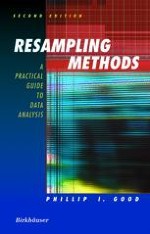2001 | Buch | 2. Auflage
Über dieses Buch
"Most introductory statistics books ignore or give little attention to resampling methods, and thus another generation learns the less than optimal methods of statistical analysis. Good attempts to remedy this situation by writing an introductory text that focuses on resampling methods, and he does it well."
— Ron C. Fryxell, Albion College
"...The wealth of the bibliography covers a wide range of disciplines."
---Dr. Dimitris Karlis, Athens University of Economics
This thoroughly revised second edition is a practical guide to data analysis using the bootstrap, cross-validation, and permutation tests. It is an essential resource for industrial statisticians, statistical consultants, and research professionals in science, engineering, and technology.
Only requiring minimal mathematics beyond algebra, it provides a table-free introduction to data analysis utilizing numerous exercises, practical data sets, and freely available statistical shareware.
Topics and Features:
* Offers more practical examples plus an additional chapter dedicated to regression and data mining techniques and their limitations
* Uses resampling approach to introduction statistics
* A practical presentation that covers all three sampling methods: bootstrap, density-estimation, and permutations
* Includes systematic guide to help one select the correct procedure for a particular application
* Detailed coverage of all three statistical methodologies: classification, estimation, and hypothesis testing
* Suitable for classroom use and individual, self-study purposes
* Numerous practical examples using popular computer programs such as SAS®, Stata®, and StatXact®
* Useful appendixes with computer programs and code to develop individualized methods
* Downloadable freeware from author’s website: http://users.oco.net/drphilgood/resamp.htm
With its accessible style and intuitive topic development, the book is an excellent basic resource for the power, simplicity, and versatility of the bootstrap, cross-validation, and permutation tests. Students, professionals, and researchers will find it a prarticularly useful handbook for modern resampling methods and their applications.
Anzeige
